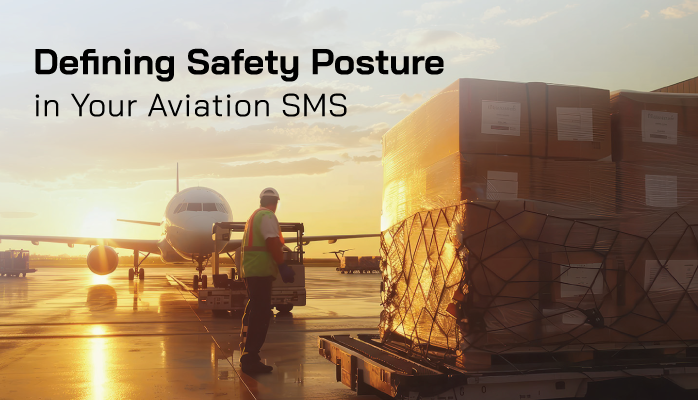What Is Safety Posture in Aviation SMS

Aviation service providers should be aware of what level of risk is and isn’t acceptable. In other words, when you perform a risk assessment on a safety concern, what amount of risk requires mitigating actions, and what amount of risk requires no actions? What amount of risk is acceptable.
Safety posture in SMS is largely about how you define an acceptable level of safety. Different organizations will tolerate different levels of risk. Some aviation service providers will accept much risk, and other service providers have almost no tolerance beyond minimal risk.
Because of this, your organization probably falls into one of the following categories:
- Paranoid safety posture
- Almost no tolerance for risk
- Willing to delay or cancel mission at the slightest sign of threat (whether real or not)
- Does not accept most types of risks
- Restrained safety posture
- Some tolerance for risk
- Focus on performance, but not afraid to delay/cancel mission at potential threat
- Does not accept many types of risks
- Promiscuous safety posture
- Moderate degree of risk acceptance
- Focus on mission and quality performance, and will cancel delay only with good justification
- Willing to accept some types of risks
It’s also essential to recognize that safety posture is both:
- How much risk you accept; AND
- What kinds of risk you accept/don’t accept
Which Safety Posture Should Your SMS Have
Obviously, there is not one right answer, other than:
- Adopt the safety posture that best fits the goals of your organization;
- Adopt the approach that is justified and reasonable given the history of risk in your niche of aviation service.
If your aviation service niche has a strong history of safety incidents, you should consider adopting a paranoid posture. If your goals and history are in line with a promiscuous posture, then perhaps that is the way to go.
That being said, the important points are this:
- Make sure you actually have a CLEAR safety posture; and
- Most likely, you will fall somewhere between paranoid and promiscuous.
To summarize, your safety posture should be a combination of:
- Company goals;
- Your type of service; and
- History of risk in your organization/type of service.
A charter helicopter company, for example, will likely accept much more risk than a Part 135 airline.
How to Define Your Safety Posture

You can define your safety posture for your SMS in several ways:
- Documentation of acceptable/unacceptable safety behavior and formalize it in a policy;
- Create a mandatory/voluntary reporting policy;
- Clearly define your criteria for each level of severity/likelihood on your risk matrix;
- Clearly document which risk assessments are/aren’t within an acceptable level of safety (ALoS); and
- Document risk assessment on each hazard/risk in your hazard register (this helps you understand what types of risks are of concern to your organization).
Having a well-documented safety posture means clearly understanding the relationship between certain actions/risks, and how your organization does/doesn’t respond.
It should also be clear that having a strong safety posture involves both:
- Your organization takes a stance on safety;
- Your organization clearly and thoroughly documents that stance.
Related Aviation Risk Assessment Articles
- 4 Pillars | What Is Risk Assessment in Aviation SMS
- What Is a Risk Matrix and Risk Assessment in Aviation SMS
- What Are Hazard Risk Assessment and Hazard Risk Analysis in Aviation SMS
Why Is Safety Posture Important
Safety posture is important for several reasons:
- Manage expectations for employees (behavior);
- Practice due diligence in aviation SMS;
- Justify your actions;
- Ensure that safety management operations are in line with goals;
- Better communicate to all employees why certain actions are/aren’t taken; and
- Ensure that safety operations are happening as best fits your resources
How to Assess If Your Safety Posture Is Good
You won’t know if your safety posture is good until your SMS:
- Has completed 4 phases of SMS implementation;
- Has full safety monitoring capabilities; and
- Has enough history to assess past performance.
If your SMS is young, not implemented, or doesn’t have needed resources, then having the right safety posture should be the least of your concerns.
However, once your SMS is implanted, and you have the resources needed for good safety management, it’s time to assess your safety posture. Fortunately, assessing your safety posture is easy:
- Is your SMS performing well?
- Are you avoiding repeat safety incidents?
- Are you avoiding significant negative trends?
These should be reasonably easy questions to answer. If you are answering yes, then your posture is probably working. If you are answering no, then you should revisit:
- What types of risks your organization is being more tolerant of that maybe it shouldn’t be; and
- Whether or not you should be enforcing a more paranoid posture regarding what risk assessments are acceptable.
Then, let some time pass (i.e., 6 months or a year) and re-evaluate to see how performance has changed.
Last updated April 2025.





